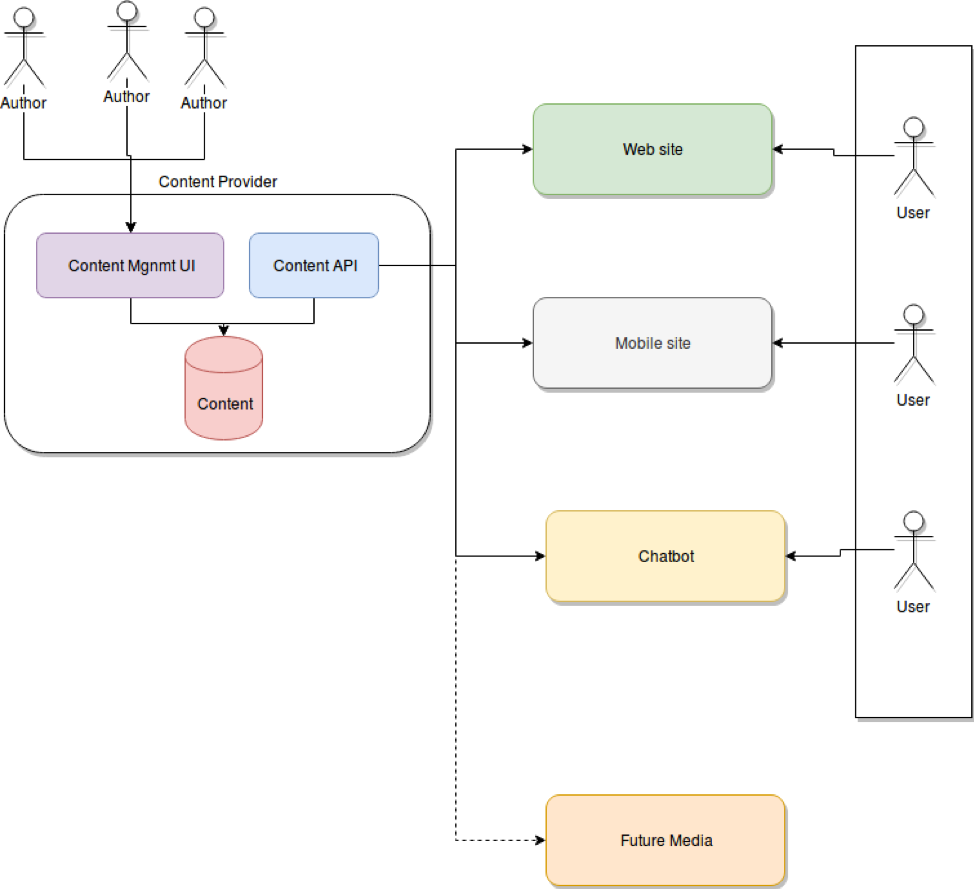
GSD
Content as a Service: Your Guide to the What, Why, and How
Posted by Fernando Doglio on October 20, 2023
Table of contents
Introduction
Content needs to be accessible across multiple platforms today. The author writes the content once and it’s published everywhere. This is the principle of Content as a Service, decoupling the actual content from the medium in which it is presented.
What is Content as a Service?
Content as a Service provides raw content for other platforms to consume and make use of according to their particular needs. This happens usually on the cloud, with a centralized platform that can be globally accessible and provides a standard format for your content.
With Content as a Service, content is centralized into a single repository, where you can manage it, categorize it, make it available to others, search for it, or do whatever you wish with it.
Content is anything usable for information, including text, video, sound, spreadsheets, binary files, and the meta-data from the preceding elements qualifies as content.
A more formal and direct definition of what a Content as a Service platform could include:
- Access to the content: Here is where a structured format for querying the content comes into play. You need to provide some form of filtering and querying capabilities for consumers to find the content they need.
- A content model: Standardizing content will enable consumers to make intelligent use of it.
- A centralized, global authoring platform: Content authors will benefit from having a single (centralized), reliable platform where they can upload their content. From here, you can also make sure they take the necessary steps to make it available to the right audience ( tagging content, managing access rules, and so on).
- Centralized storage: Keeping the content in one centralized place where both the repository and the authoring platforms can reside in the cloud.
- Metadata definitions: Metadata helps enrich the content in a way that improves the experience of the consumer, both while searching for it and once they’ve found it and are ready to make use of it.
Why Content as a Service?
There are many reasons why you’d want to go through the hurdles of either upgrading your current CMS into one that is based on serving content as a service, like a headless cms, or installing one where there was nothing before.
The key deciding factor at the end will be your current context. Here are three very obvious challenges you may be experiencing where Content as a Service would serve your content strategy well.
Siloed content
When your company is dealing with multiple sources of content daily, having to manage them all independently requires extra resources, added overhead and a waste of time.
You’re most likely dealing with one (probably more) of these situations:
- You don’t have a common content format, something you can easily distribute and use.
- You don’t have a centralized way to make the content available for consumers, be they internal or external ones.
- Metadata is just something you read about on the web (if at all) but not something you use every day to empower your content consumers.
- And centralized storage is by definition, out of the question, adding extra effort required to move from one source of data to the next.
A switch into a content-centric approach, content as a service would directly improve your performance. Having a content-first approach here would allow you to think differently about your clients or team and about what you’re trying to do every day for them.
If this is you, consider moving into a Content as a Service platform as soon as possible.
Limited formats for your content
Extending content reach can be challenging due to the compatibility of your content with different formats however Content as a Service addresses all forms of content delivery and channels.
Many CMSs, such as Wordpress, assume the responsibility for presentation, ensuring that you don’t have to worry about it. This is perfect if you do not have the resources to build a cohesive look for all platforms for which your content exists, however, this also limits your coverage to only the devices that Wordpress’s representation of your content is compatible. And while it is true that their pages are quite compatible with both computer and mobile screens, there are many devices where your content is immediately rejected or just not pleasant to be consumed in.
For instance, have you ever considered how your Wordpress page would look like in a SmartWatch? What about a VR headset? You must ensure that you’re compatible with the future, especially when new technologies are being developed and released to the public every day. Content needs to be an abstract entity, and choosing the way it looks (or to keep it generic, the way it is consumed) needs to be the task of your clients.
For our Wordpress example, one solution may be to either use their REST API or migrate entirely to a headless CMS such as ButterCMS in order to fully gain their benefits. With both of these solutions, you’ll need developer resources.
Native mobile app needing content
There are different ways to tackle mobile development, and one great way to manage the content is with a mobile cms service. Content comes in many forms, and the most traditional CMSs available only provide web-compatible formats (such as HTML). In those cases, that format might not be the best fit for your app and would require you to work around that by adding extra support. There is a better solution!
Using a headless CMS or a Content as a Service approach can simplify your work. Here your options are quite straightforward: you transfer your presentation-less content to your clients’ applications and there, they can choose how to format it and display it to their users. You don’t need to worry about that part when authoring it and managing it.
The Content as a Service approach provides your team with the flexibility to use content to meet any use case requirement now and in the future.
When not to pursue Content as a Service?
Only a single use case for your data
If you have only a single use case for your data, switching to a Content as a Service approach would be the equivalent of using a shotgun to kill a fly. If you don’t need to worry about multiple channels or multiple representations of your data then Content as a Service is overkill.
Limited tech resources
If you need full control over how your content is supposed to look, but you don’t have the technical chops or resources to do so then a Content as a Service approach will be a poor fit. If this is a problem for you, likely a traditional CMS is your best bet. You don’t need to worry about building the presentation layer because that comes with the CMS, and you also have all the benefits of a centralized platform for content management.
Content as a Service Use Cases
Based on the above motivations to use a Content as a Service strategy for your projects, here are some classical use cases:
Mobile apps with a need for content
Mobile apps aren’t necessarily known for being really compatible with web content. Yes, they can render it using some particular components, but that content will visually jump out at you.
Also, if you think about it, having web content available, and not using it for web browsers makes little sense. In these cases where your content is only meant to be rendered in a mobile app, you would benefit greatly from splitting content and representation and allowing your own app to render your content the best possible way.
Multi-channel needs
If instead, your problem is that you need your content to reach as many channels as possible, like going for Web, Mobile, SmartWatches, your SmartTV and (why not) your eventual SmartFridge, what you need is a way to distribute that content from a centralized location.
Solving these types of problems is one of the reasons why we have Content as a Service providers. As long as you’re working with one of them, there is nothing extra you should be doing. It’s up to your clients (or content consumers if you will) to decide how to use your content however best suits their needs.
Highly customizable UX
Another use case is allowing your content consumers to customize your content’s presentation however they might want. By serving your content through an API and in a generic format, like JSON, where you have a predefined structure for it, your clients can pick and choose different parts from the content and use them however they need. In fact, this approach would actually allow different consumers to render the exact same piece of content in different ways.
Content Marketing and content analysis
In addition to providing different ways of presenting content and reaching other media, marketing platforms can analyze content to understand different things using machine learning and NLP (Natural Language Processing) techniques.
For example:
- Sentiment analysis to understand the tone of an article to ensure they transmit the message in the intended way.
- Automated topic generation based on content keywords, helping tag and categorize content automatically.
- Content conversion performance based on reader behavior to understand what works and what doesn’t.
- You can even create virtual assistants and chatbots based on content from articles to understand how to provide extra help to customers based on your knowledge base.
How Does Content as a Service Work?
From a technical point of view, Content as a Service can be considered a pattern, a way of architecting your platform in order to obtain the benefits mentioned above. The actual implementation remains custom, as with any architectural pattern, but if you wanted to have a general overview of how a Content as a Service platform might work, here is a diagram:
The Content Management UI refers to a web application, one that centralizes all content authoring and content management of the platform. Here is where everything content-related happens.
Content is then centrally stored. The format for that and the technology used is not relevant at this point, anything that fulfills the intention of correctly storing data is good enough.
Lastly, the content is made available through a technology-agnostic API, meaning your platform shouldn’t care about the technology used to get the content. As long as they can speak with it, they’re fine. Normally, this is done with a REST API, as is usually the industry standard. But given the current trends, we should soon start seeing similar setups using GraphQL.
If you consider the box, “Content Provider” in the above diagram as a black box, you can think of solutions such as a ButterCMS or headless Wordpress as valid options. With these products, you’d be using their own platform to author the content whilst working on the presentation layer, comprising whatever set of applications you might need (maybe web apps, mobile apps and others). You could, as an alternative, also provide access to the public APIs of these platforms, allowing others to take care of building their own presentation layers and saving you the trouble of working on that.
Content as a Service in the Wild
It isn’t easy to find examples of sites or companies that advertise the use of these platforms since they are considered part of the base infrastructure or technical stack used to create them. A few who do are:
- Spotify for artists: This side of Spotify allows content creators to upload their content and reach their audience without having to worry about the presentation. As an artist, you’re able to provide the content that other platforms will later consume and get insight into what content gets consumed and in what manner. You’re basically benefiting from all the attributes mentioned before, applied specifically to the music industry.
- Arrive: They handle their blog, team pages, and news posts all using a headless CMS.
- Lyft’s blog: They share product updates and all sorts of news about their business through this platform. This is a classic use of a Content as a Service platform: pulling data and creating a blog with it.
- Doorsteps: They have a lot of their articles and content inside a headless CMS. This enables them to improve their SEO ranking (through the articles) and through the search capabilities of the CMS, they’re using to search content related to queries done on their site to improve their customer’s experience.
- Google’s training platform claims to use a similar headless CMS setup, allowing them to provide the same content for both Android and iOS devices without the need to duplicate the effort
- The Container Store uses as well a headless CMS to empower their marketing team to create compelling content without the need of developers formatting it for the right media.
- Instrument uses a headless CMS with a static site generator to create their site, independently from the content authoring process.
Conclusion
Hopefully, by this point, you have a pretty good idea of what Content as a Service means, how it works, and why, if at all, you should use such a strategy.
When it comes to content that has value to multiple audiences, content as a service allows systems to scale without impacting performance and also serves at a global level.
And to make things even easier, there are quite a few companies providing content as a service with bindings to all the common programming languages, making it even easier for you or your developers to integrate with them.
Let us know in the comments if you’ve ever used one of these systems and what your experience has been with them!
Do you want your product or marketing team to test Butter CMS? We can set up a live demo to walk your team through the fast, easy-to-use interface.
ButterCMS is the #1 rated Headless CMS
Related articles
Don’t miss a single post
Get our latest articles, stay updated!
















Fernando Doglio has been working as a Web Developer for the past 10 years. In that time, he's come to love the web, and has had the opportunity of working with most of the leading technologies at the time, suchs as PHP, Ruby on Rails, MySQL, Node.js, Angular.js, AJAX, REST APIs and others. He can be contacted on twitter at: @deleteman123 or you can read more about him and his work at www.fdoglio.com